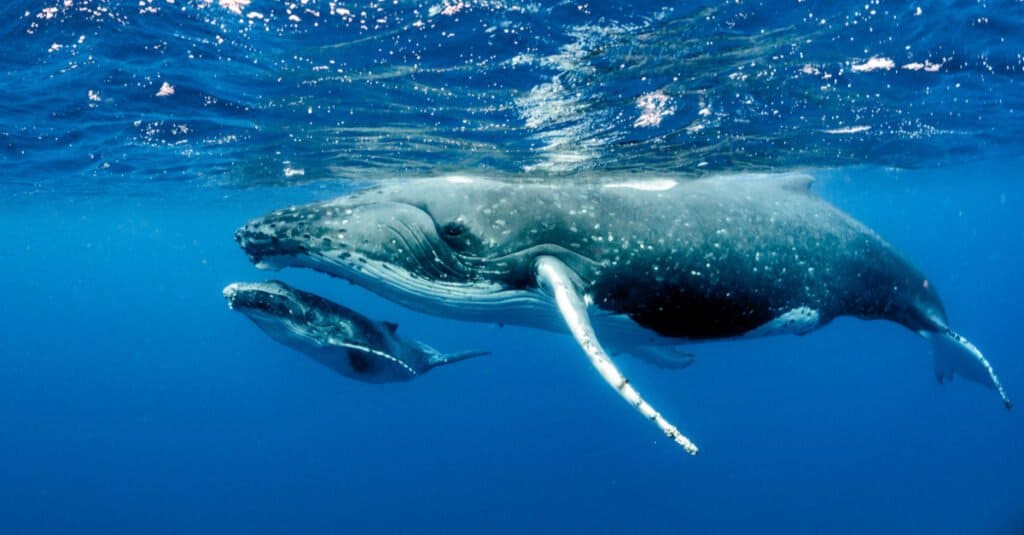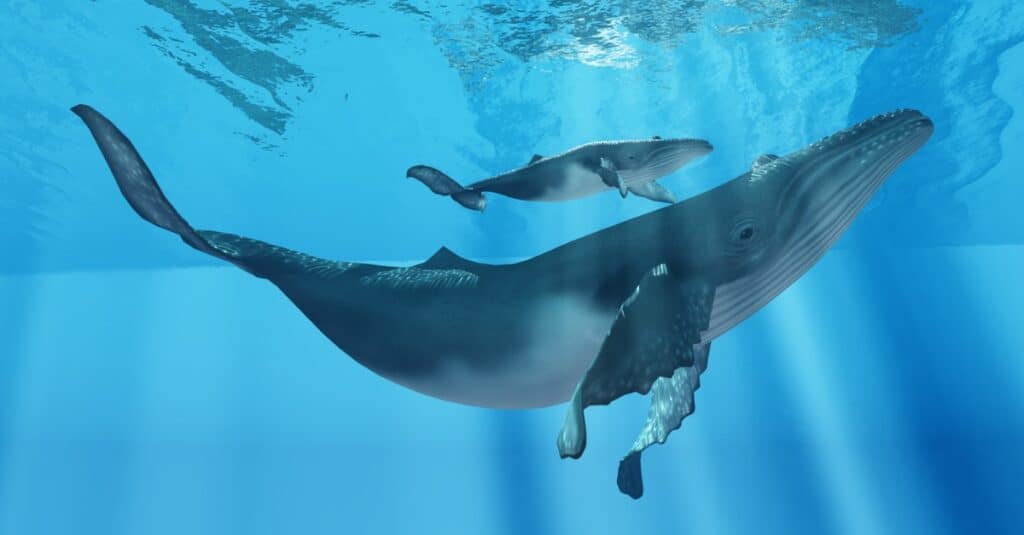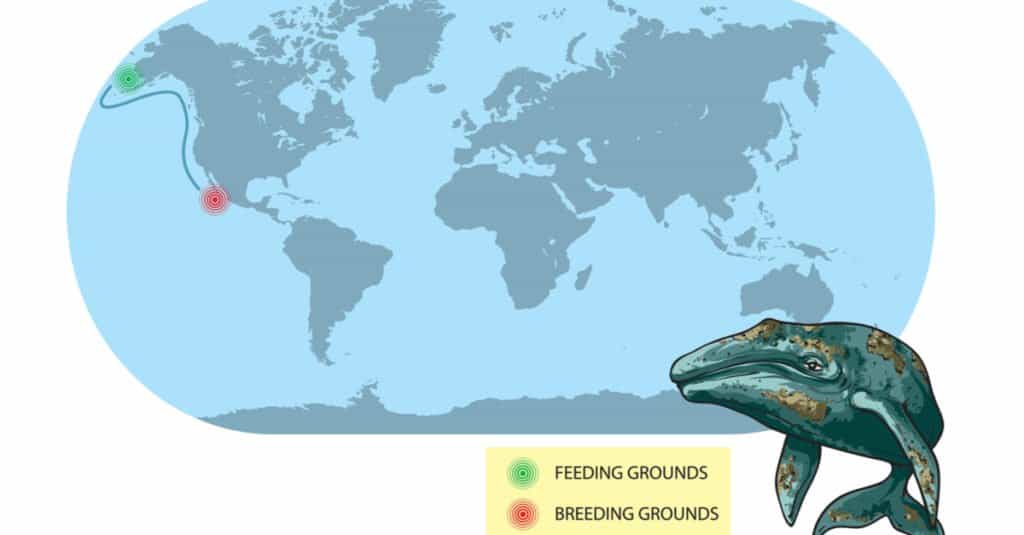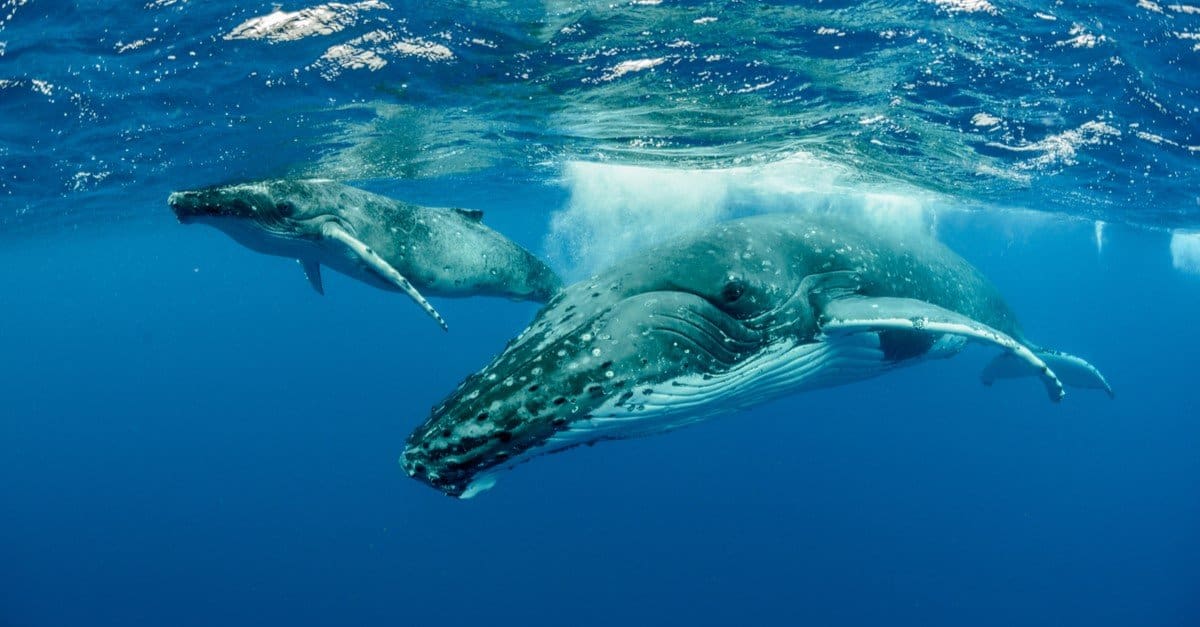Whales are the largest animals on the planet, and their babies can be absolutely massive. Blue whale calves can be up to 25 feet long at birth and weigh 3 tons, that’s larger than the largest great white on record! Once out of the womb they can add 200 pounds per day, which is the size of a fully grown adult. With the massive size of whale babies, you might be wondering what whale gestation periods are. Let’s dive into how long whales are pregnant, and how different whale species compare!
How Long Are Whales Pregnant?

mother and baby humpback whale swimming together
©Imagine Earth Photography/Shutterstock.com
What do whales, camels, and donkeys have in common? They’re three of the animals with the longest gestation period. Between the three of them, they can be pregnant for around 40 months. (And we thought nine months was rough.)
Whales are most commonly in the gestation period from 10-18 months. They’re part of the cetacean aquatic infraorder of 90 species that includes dolphins and porpoises. Marine mammals, like us, need oxygen and nurse their young.
And it all begins with finding a partner which is a mixed bag in the whale kingdom. Whereas most toothed whales have no “long term commitments,” baleen whales (whales that have plates of whalebone in the mouth for straining plankton from the water) are mostly monogamous. This is the case during each reproductive period.
Gestation Periods of Different Whale Species

Mother and baby
Beluga whale
swimming together. Toothed whales use echolocation to navigate in murky water with low visibility.
©CampCrazy Photography/Shutterstock.com
Earlier we said that whales could have gestation periods spanning 10 to 18 months which is a gap nearly as long as a human pregnancy. Let’s look a deeper look at the gestation period for different whales:
Orca 15-18 mo.
Sperm 14-16 mo.
Humpback 11 mo.
Beluga 14-15 mo.
Blue 10-12 mo.
Narwhal 14 mo.
Fin 11 mo.
Gray 12 mo.
N. Atlantic Right 12 mo.
Common Minke 10 mo.
Southern Right 12 mo.
Sei 11 mo.
Short-Finned Pilot 15 mo.
Dwarf sperm 274 days
Baiji 10 mo.
Long-Finned Pilot 16 mo.
Northern Bottlenose 12 mo.
Sowerby’s Beaked 12 mo.
How Long are Blue Whales Pregnant? Does Size Effect Whale Pregnancy Length?
During pregnancy, whale embryos are fed by the placenta which receives nutrients from the mother’s bloodstream. Sound familiar?
Their size is irrelevant to how long they carry their offspring. The porpoise and the blue whale — the largest animal on Earth — both carry their young for around 11 months.
The longest gestation period for a dolphin is the killer whale, which can extend to 18 months! Researchers believe the longer gestation period of killer whales aids in the development of their advanced brains.
How Whale Calves Are Born

A humpback whale mother with her calf
©iStock.com/CoreyFord
Calves are born tail-first. Once they’ve delivered, mothers carry them to the surface to get their first breath of oxygen. They nurse on her high-fat content milk, from 16-46 percent, and grow rapidly in size and weight to the tune of 60 lbs. a day as is the case with gray whale calves.
(And once again, blue whale babies can grow by 200 pounds per day!)
Usually, only one calf is delivered since mothers don’t produce enough milk to feed twins. Nursing can last from 4 months to over a year for some whales. During that time, mothers and calves form a tight bond. The young ones will stay with their mothers until they can hunt on their own and they join the migration.
Whale Migration and Reproduction

Gray whales will migrate from the waters off Alaska to birthing areas in Mexico
©EreborMountain/Shutterstock.com
Some whales are always on the move and others, like the toothed whale, not-so-much. Two of the reasons why whales migrate is so they can feed and give birth in warmer waters. Their calves won’t be born with enough blubber to withstand intensely cold conditions and their bodies don’t need the undue stress.
There are variations of migrating. For example, it’s the pregnant female of the right whale species that migrates. With humpbacks, both sexes migrate.
Most toothed whales seem to have no migrating habits. With sperm whales, the females and calves stay in the breeding grounds close to the Equator for their entire lives while the males tend to venture into colder waters alone while not breeding.
Baleen whales migrate, have been tracked and recorded, and appear to have similar patterns on their journeys. Both humpback and gray whales migrate extensively.
“…Both species have migrations that total over 10,000 miles round trip, with the longest recorded migration being a 13,988 mile journey by a gray whale from Mexico to Russia and back. These animals have not only the longest migrations for whales—it is the longest migration for any mammal.”
For most species, reproduction is seasonal, each winter and spring, and ovulation coincides with male fertility naturally.
Certain whales can go months without eating.They metabolize energy, during the spring and summer, from the oil in their bone marrow and blubber. During those feeding months, they can eat as much as 4% of their body weight each day.
Suffice it to say, these cetaceans seem to have a system down that works in every way for them. Their coupling, their migration and gestation, the birth experience, the bonding that takes place… We could learn a lot from these one-of-a-kind creatures! But we probably won’t be eating any plankton or giant squid any time soon.
Final note: This information is based on a natural phenomenon occurring in wild cetaceans and not those in captivity. Captive whales can have a life expectancy of only up to ½ of those in the wild. Also, their behaviors can be extremely different and sometimes the exact opposite of what happens in nature.
Thank you for reading! Have some feedback for us? Contact the AZ Animals editorial team.








